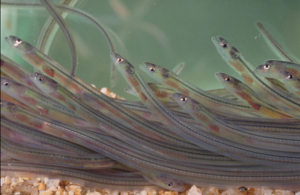
This article has been published in the Journal of FISH BIOLOGY [1]. It contributes to our understanding of glass eel migration by estimating migration time and speed, particularly in the challenging Mediterranean coastal and lagoon environments.
You can access to it on the Tour du Valat web documentary portal [2].
Abstract:
Migration speed can have important evolutionary consequences as it can affect the timing of arrival, remaining energy reserves, and habitat choice. Environmental conditions and individual phenotypic traits can impact the migration speed of individuals. In this way, estimating migration speed is of particular importance, especially for species under strong management strategies and colonizing highly diversified habitats, as is the case for the European eel. However, estimating the migration speed of glass eels, which is the life stage when eels colonize continental habitats, presents challenges due to typically low re-capture probabilities and difficulties in tagging individuals. Using recruitment time series at two sites, one at the sea connection and another inland, we estimated the temporal lag between the two migration peaks to compute migration speed. Because we worked on the Mediterranean coasts and in a lagoon, the weak tidal amplitudes may inhibit individuals from efficiently performing the selective tidal stream transport. We obtained migration speed values coherent with the few values available in the literature for Atlantic estuaries. The values we obtained that are lower than those obtained for Atlantic estuaries are also coherent with the weak tides along the Mediterranean coasts and lead to necessary further studies to understand the migratory behavior of glass eels in such hydro-systems.
Bibliographic reference: Bouchard, C., & Nicolas, D. (2023). Estimating migration speed of glass eels during their colonization of a Mediterranean lagoon. Journal of Fish Biology, 1–9. https://doi.org/10.1111/jfb.15514 [3]